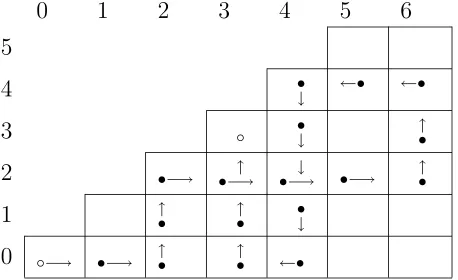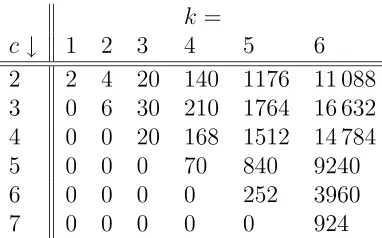23 11
Article 05.4.3
Journal of Integer Sequences, Vol. 8 (2005), 2
3 6 1 47
A Note on the Enumeration of Diffusion
Walks in the First Octant by Their Number
of Contacts with the Diagonal
Heinrich Niederhausen
Department of Mathematical Sciences
Florida Atlantic University
Boca Raton, FL 33431
USA
[email protected]
Abstract
Diffusion walks take steps in the four directions N, E, S, and W. We derive a closed form for the number of diffusion walks from the origin to some point (n, n) on the diagonal ink steps inside the first octant, touching the diagonal exactlyc times.
1
Notation and Results
A diffusion walk is a random walk in the square lattice Z2, equally likely taking one of the four unit steps N orth = (0,1), South = (0,−1), East = (1,0), and W est = (−1,0). The walk stays in the first octant, also called principal wedge, if it only visits lattice points (n, m) satisfying 0≤m≤n. We will call such restricted diffusion walksoctant walks in this paper. We denote byD2k(0→n;c) the number of octant walks from (0,0) to (n, n) taking 2k steps
0 1 2 3 4 5 6
Table 1: A diffusion walk in the first octant from (0,0) to (3,3) with 20 steps and 4 contacts
We prove in this paper that D2k(0→n;c) =
Of course, there are various ways to shorten this expression; for example, D2k(0→n;c) =
¡2k+2
We leave it to the reader to show that the total number of walks in the first octant ending somewhere on the diagonal after 2k steps and c visits equals
X
This follows from (1), but there may be better arguments, noticing the (generalized) Catalan numbers in the formula. Another challenge is an elementary proof showing that the number of octant walks with l steps and c visits (ending anywhere) equals f(l, c) =
c a generating function for D2k(0→n;c), and on some computer experiments by my student
k =
c↓ 1 2 3 4 5 6 2 2 4 20 140 1176 11 088 3 0 6 30 210 1764 16 632 4 0 0 20 168 1512 14 784 5 0 0 0 70 840 9240 6 0 0 0 0 252 3960 7 0 0 0 0 0 924
Table 2: The number of octant walks contacting the diagonalctimes, and ending there after 2k steps
l =
c↓ 1 2 3 4 5 6 7 8 1 1 1 3 6 20 50 175 490 2 0 2 3 8 20 60 175 560 3 0 0 0 6 10 45 105 420 4 0 0 0 0 0 20 35 224 5 0 0 0 0 0 0 0 70
Table 3: The number of octant walks with l steps, and c contacts with the diagonal
to that section. In Section 3 we extract the coefficients D2k(0→n;c) from the generating
function. This involves finding a closed expression for a double sum. We have been assured that computer algebra can do such a summation; however, it is also easily done by classical arguments, which we sketch in that section.
2
The Contact Generating Function
Janse van Rensburg [1],[2] investigated the more general problem considering walks that end somewhere inside the octant, instead of just on the diagonal. Let Dk(0→(j, l) ;c) be the number of diffusion walks from (0,0) to (j, l) taking k steps in the first octant contacting the diagonaly=x exactlyc times, thusD2k(0→n;c) =D2k(0→(n, n) ;c), and let
rk(j, l; 0,0) = X
c≥0
Dk(0→(j, l) ;c)zc.
In Table4 the first few generating functionsrk(j, l; 0,0) are shown, where each cell (j, l) (in double frames) is subdivided into subcells for k = 1,2,3,4.
l= 2
l= 1
l= 0
z2+z3
z2 2z2+ 3z3 z+z2 2z+z2
z2 z2+ 2z3 z z+ 2z2 z 3z+ 3z2 z
k= 1 2 3 4 1 2 3 4 1 2 3 4 1 2 3 4
j = 0 j = 1 j = 2 j = 3
Table 4: The generating functions rk(j, l)
Omitting many details he finally derives for k ≥l+j >0,
rk(j, l) =z
∞
X
m1=0 ∞
X
m2=0
(z−1)m1+m2U
k(j+m1+m2, l+m1−m2) (2)
=z
∞
X
i=0
i X
q=0
(z−1)iUk(j+i, l+i−2q),
where Uk(n, m) =
(m+ 1) (2 +n) (m+ 3 +n) (n+ 1−m) (k+ 1) (k+ 2) (k+ 3)2
µ
k+ 3
1
2(k+n−m) + 2
¶µ
k+ 3
1
2(k+n+m) + 3
¶ . (3)
Only for 0≤m≤n we can say that Uk(n, m) equals the number
Dk(0→(n, m)) :=X
c≥0
Dk(0→(n, m) ;c)
of all octant walks from (0,0) to (n, m) in k steps. For an elementary derivation of this result and references see [3]. In the generating function (2) we mean the formula for
Uk(j+m1 +m2, l+m1−m2), not the number of walks, i.e.,Uk(j+m1+m2, l+m1−m2)
is not vanishing everywhere outside the first octant (unfortunately, this distinction was not made by Janse van Rensburg, aggravating the error in the formula [1, (4.186)],[2, (3.23)] for
Uk(n, m)). Indeed, for the proof of (2) it is essential that
Uk(n, n−2q) =−Uk(n,2q−n−2), (4) a symmetry not shared by the counts Dk(0→(n, m)).
In the following proposition we verify (2) in an elementary way.
Proposition 2.1. [2] If the binomial coefficient ¡u v ¢
is defined the usual way, ¡u v ¢
= 0 if
v > u or v <0 or v not an integer, and Uk(n, m) is given as in (3), then
X
c≥0
Dk(0→(j, l) ;c)zc =z k−j X
i=0
(z−1)i
i X
q=0
Uk(j+i, l+i−2q)
Proof. Let σk(j, l) := zPk−j
using equation (4). Ifiis odd the two inner sums cancel each other. For evenithe difference equals −Uk(i+j,−1), which is also 0.
Finally we verify (6), noting that
z(σk−1(j, j−1) +σk−1(j + 1, j))
= (z−1) (σk−1(j, j−1) +σk−1(j + 1, j)) +σk−1(j, j −1) +σk−1(j + 1, j)
using Uk−1(j −1 +i, j+i) = 0 and Uk−1(j+i, j + 1 +i) = 0 in the last step. Hence
z(σk−1(j, j −1) +σk−1(j+ 1, j)) = σk−1(j −1, j)+σk−1(j, j+ 1)+σk−1(j, j−1)+σk−1(j+ 1, j)
=σk(j, j), as desired.
3
Summing the Double Sum
Extracting the coefficient ofzc from the contact generating function
X
Finding a closed form for this double sum is completely elementary under the right approach; first note that (9) can be written as
D2k(0→n;c) =
It easily follows by induction over N that
s(N, k, m) = (2k−2N + 2) (m+N + 2)−(2k−2N + 3) (k+ 1)
References
[1] E. J. Janse van Rensburg, The Statistical Mechanics of Interacting Walks, Polygons, Animals and Vesicles, Oxford University Press, Oxford, UK, 2000.
[2] E. J. Janse van Rensburg, Adsorbing staircase walks and staircase polygons, Ann. Com-binat. 3 (1999), 451–473.
[3] H. Niederhausen, Random Walks in Octants, and Related Structures. To appear in J. Statist. Plann. Inference (2005), doi:10.1016/j.jspi.2005.02.013.
2000 Mathematics Subject Classification: Primary 05A05; Secondary 05A15.
Keywords: random walks, diffusion, contacts, adsorption.
(Concerned with sequence A005558.)
Received October 29 2004; revised version received September 1 2005. Published inJournal of Integer Sequences, September 1 2005.


